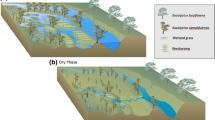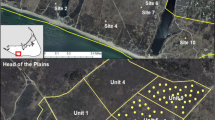Abstract
Greentree reservoir (GTR) management is a common waterfowl habitat management technique used in both the northeastern and southeastern United States. However, this management technique is controversial because greentree reservoir management can cause changes in forest composition and structure. We studied the effects of GTR management at the Montezuma National Wildlife Refuge in central New York by comparing vegetation in permanent plots in two GTRs and a natural forest wetland over 30-year period (preflood and 2 years and 18 years after flood cessation). We detected long-term effects of GTR management on vegetation composition and structure. Red maple and green ash remained the dominant overstory species, but density of green ash saplings was higher (P=0.026) in a natural forested wetland (300 trees/ha) compared to the two GTRs (30–90 trees/ha). Age determinations of several green ash saplings suggest these changes were likely caused by reduced regeneration in the GTRs. Mortality of green ash seedlings in 1996 was greatest in a GTR flooded for 1 year (60%) versus an unflooded GTR (12%) and a natural forested wetland (27%). Overall, shrub density was similar 18 years post-flooding and preflooding, but several species had lower densities (P=0.001–0.031) than a natural forested wetland. Shannon-Weiner diversity index (1.8–2.0) and richness (29–31) of herbaceous species were similar among all sites 18 years after flood cessation. However, two species of fern remained at lower densities (P=0.0001–0.026), while three herbaceous species remained at higher densities (P=0.0001–0.015) 18 years after flood cessation as compared to preflood densities and densities in a natural forested wetland. It is unknown after which year of flooding these changes occurred, but 12 years of GTR management did cause long-term effects on the forest community.
Similar content being viewed by others
Literature Cited
Broadfoot, W. M. 1967. Shallow-water impoundment increases soil moisture and growth of hardwood. Soil Science Society of America Proceedings 31:562–564.
Broadfoot, W. M. and H. L. Williston. 1973. Flooding effects on southern forests. Journal of Forestry 71:584–587.
Christman, S. P. 1984. Breeding bird response to greentree reservoir management. Journal of Wildlife Management 48:1164–1172.
Davison, S. E. and R. T. T. Forman. 1982. Herb and shrub dynamics in a mature oak forest: a thirty year study. Bulletin of the Torrey Botanical Club 109:64–73.
Deller, A. S. 1996. Effect of greentree reservoir management on the vegetative and breeding bird communities on the Montezuma National Wildlife Refuge. M.S. Thesis. State University of New York, College of Environmental Science and Forestry, Syracuse, NY, USA.
Dunn, C. P. 1986. Shrub layer response to death ofAlmus americana in southeastern Wisconsin lowland forests. Bulletin of the Torrey Botanical Club 1113:142–148.
Fredrickson, L. H. 1979. Floral and faunal changes in lowland hardwood forests in Missouri resulting from channelization, drainage, and impoundment. U.S. Fish and Wildlife Service, Office of Biological Services, Washington, DC, USA FSW/OBS-78/91.
Fredrickson, L. H. and D. L. Batema. 1993. Greentree reservoir management handbook. Gaylord Memorial Laboratory, University of Missouri-Columbia, School of Natural Resources, Gaylord Memorial Laboratory, Puxico, MO, USA. Wetland Management Series Number 1.
Gleason, H. A. and A. Cronquist. 1991. Manual of vascular plants of northeastern United States and adjacent Canada. The New York Botanical Garden, Bronx, NY, USA.
Golet, E. C. 1969. Growth of muck-hardwoods in a New York waterfowl impoundment. M.S. Thesis Cornell University, Ithaca, NY, USA.
Golet, F. C., A. J. K. Calhoun, W. R. DeRagon, D. J. Lowry, and A. J. Gold. 1993. Ecology of red maple swamps in the glaciated northeast: a community profile. United States Department of the Interior, U.S. Fish and Wildlife Service, Washington, DC, USA. Biological Report 12.
Good, N. F. and R. E. Good. 1972. Population dynamics of tree seedlings and saplings in a mature eastern hardwood forest. Bulletin of the Torrey Botanical Club 99:172–178.
Hall, T. F. and G. E. Smith. 1955. Effects of flooding on woody plants, West Sandy Dewatering Project, Kentucky Reservoir. Journal of Forestry 53:281–285.
Haramis, G. M. 1975. Wood duck (Aix Sponsa) ecology and management within the green-timber impoundments at Montezuma National Wildlife Refuge. M.S. Thesis. Cornell University, Ithaca, NY, USA.
Hosner, J. F. 1958. The effects of complete inundation upon seedlings of six bottomland tree species. Ecology 39:371–373.
Hosner, J. F. 1960. Relative tolerance to complete inundation of fourteen bottomland tree species. Forestry Science 6:246–251.
Howard, J. A. and W. T. Penfound. 1942. Vegetational studies in areas of sedimentation in the Bonnet Carre Floodway. Bulletin of the Torrey Botanical Club 69:281–289.
Hutton, F. Z. 1972. Soil survey of Seneca Country, New York. United States Department of Agriculture, Washington, DC, USA.
Jones, R. H. and R. R. Sharitz. 1989. Potential advantages and dis-advantages for germinating early for trees in floodplain forests. Oecologia 81:443–449.
Jones, R. H., R. R. Sharitz, and K. W. McLeod. 1989. Effects of flooding and root competition on growth of shaded bottomland hardwood seedlings. American Midland Naturalist 121:165–175.
Jones, R. H., R. R. Sharitz, P. M. Dixon, D. S. Segal, and R. L. Schneider. 1994. Woody plant regeneration in four floodplain forests. Ecological Monographs 64:345–367.
Karr, B. L., G. L. Young, J. D. Hodges, B. D. Leopold, and R. M. Kaminski. 1990. Effect of flooding on greentree reservoirs. United States Department of the Interior, Washington, DC, USA. Technical Completion Report G1571-03.
King, S. L. 1994. The effects of flooding regimes and green-tree reservoir management on succession of bottomland hardwoods. Ph.D. Dissertation. Texas A&M University, Corpus Christi, TX, USA.
King, S. L. 1995. Effects of flooding regimes on two impounded bottomland hardwood stands. Wetlands 15:272–284.
Kivisalu, E., L. W. VanDruff, and D. Q. Thompson. 1970. Waterfowl nesting in a green-timber impoundment. Transactions North East Fish and Wildlife Conference 27:151–166.
Klimas, C. V., C. O. Martin, and J. W. Teaford. 1981. Impacts of flooding regime modification on wildlife habitats of hardwood forests in the lower MS valley. U.S. Army Corps Engineers Waterways Experimental Station Environmental Laboratory, Vicksburg, MS, USA. Technical Report EL-81-13.
Knopf, F. L. and M. H. Smith (chairs). 1992. Biological diversity in wildlife management. Transactions of the North American Wildlife and Natural Resource Conference 57:241–342.
Krull, J. N. 1967. Association of certain groups of aquatic invertebrates with several species of submerged aquatic plants. Ph.D. Dissertation. State University of New York, College of Environmental Science and Foresty, Syracuse, NY, USA.
Lemmon, P. E. 1957. A new instrument for measuring forest overstory density. Journal of Forestry 55:667–669.
Lyford, W. H. and D. W. MacLean. 1966. Mounds and pit microrelief in relation to soil disturbance and tree distribution in New Brunswick, Canada. Harvard Forest Paper Number 15:1–18.
Malecki, R. A. J. R. Lassoie, E. Rieger, T. Seamans, 1983. Effects of long-term artificial flooding on a northern bottomland hardwood forest community. Forestry Science 29:535–544.
Newling, C. J. 1982. Ecological investigation of a greentree reservoir in the Delta National Forest, Mississippi. U.S. Army Engineer Waterways Experiment Station Environmental Laboratory, Vicksburg, MS, USA. Miscellaneous Paper EL-81-5.
Noble, R. E. and P. K. Murphy. 1975. Short term effects of prolonged backwater flooding on understory vegetation. Castanea 40:228–238.
Pearson, C. S., R. B. Child, W. E. Kennedy, W. Huff, and C. B. Lawrence. 1942. Soil Survey: Seneca County, N.Y. United States Department of Agriculture, Washington, DC, USA.
Reed, P. B. Jr., 1968. Preliminary study of green-timber impoundment. M.S. Thesis. Cornell University, Ithaca, NY, USA.
Rudolph, R. R. and C. G. Hunter. 1964. Greentrees and greenheads. p. 611–618.In J.P. Lindusky (ed.) Waterfowl Tomorrow. U.S. Department of the Interior, Washington, DC, USA.
SAS Institute Inc 1985. SAS User’s Guide: Statistics, Version 5 Edition. SAS Institute Incorporated, Cary, NC, USA.
Shannon, C. E. 1948. A mathematic theory of communications. Bell Systems Technical Journal 27:379–423.
Steel, R. G. D. and J. H. Torrie. 1980. Principles and procedures of statistics a biometrical approach. McGraw-Hill, Incorporated, New York, NY, USA.
Streng, D. R., J. S. Glitzenstein, and P. A. Harcombe. 1989. Woody seedling dynamics in an East Texas floodplain forest. Ecological Monographs 59:177–204.
Thompson, D. Q., P. B. Reed, G. E. Cummings, and E. Kivisalu. 1968. Muck hardwoods as green-timber impoundments for waterfowl. Transactions of the 33rd North American Wildlife and Natural Resources Conference, Washington, DC, USA.
VanDruff, L. W. 1971. The ecology of the raccoon and oppossum, with emphasis on their role as waterfowl nest predators. Ph.D. Dissertation. Cornel University, Ithaca, NY, USA.
Weller, M. W. 1989. Plant and water-level dynamics in an east Texas shrub-hardwood bottomland wetland. Wetlands 9:73–88.
Wigley, T. B. and T. H. Filer, Jr. 1989. Characteristics of greentree reservoir: a survey of managers. Wildlife Society Bulletin 17: 136–142.
Young, G. L., B. L. Karr, B. D. Leopold, and J. H. Hodges. 1995. Effect of greentree reservoir management on Mississippi bottomland hardwoods. Wildlife Society Bulletin 23:525–531.
Zar, J. H. 1984. Biostatistical Analysis. Prentice-Hall, Incorporated, Englewood Cliffs, NJ, USA.
Author information
Authors and Affiliations
Rights and permissions
About this article
Cite this article
Deller, A.S., Baldassarre, G.A. Effects of flooding on the forest community in a greentree reservoir 18 years after flood cessation. Wetlands 18, 90–99 (1998). https://doi.org/10.1007/BF03161447
Received:
Revised:
Accepted:
Issue Date:
DOI: https://doi.org/10.1007/BF03161447




